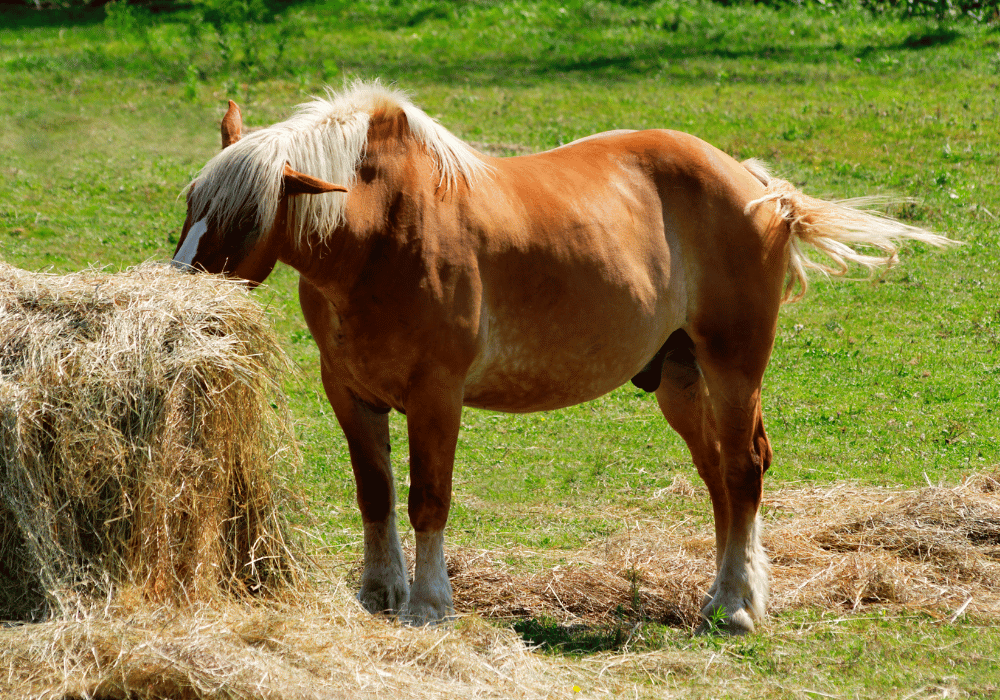Equine obesity is a growing problem, with serious implications for horse welfare. With up to 50% of horses and ponies in the UK reported to be overweight or obese, the problem is widespread. This figure increases to 70% in some native pony breeds. This blog article outlines why obesity is an equine welfare issue and what horse owners can do to monitor their horse’s weight.
Why Obesity Is Bad For Equine Health and Welfare
An overweight or obese horse is at a higher risk of developing a range of additional health issues. Some of these conditions seriously affect a horse’s quality of life and they can be fatal. Obesity is preventable and reversible, so taking action to monitor and manage your horse’s weight is key to reducing the risk of several health conditions.
Equine Metabolic Syndrome (EMS)
EMS is a condition similar to Type 2 Diabetes in humans. Whilst any horse, pony or donkey can develop EMS, overweight animals are at a much higher risk. EMS causes insulin resistance, which can lead to laminitis and other diseases.
Insulin is vital to the horse’s health because it helps to regulate blood sugar levels. Hormones produced by excessive fat cells prevent insulin from doing this, which leads to insulin resistance and higher blood sugar levels. To compensate, the body produces even more insulin, and this excess insulin ends up in the horse’s bloodstream. This is linked to laminitis, and an estimated 90% of laminitis episodes are linked to a hormonal disorder such as EMS.
By keeping your horse’s weight under control, you can reduce the risk of EMS and all of the associated health problems.
Laminitis
Research has found that horses and ponies that gain weight are almost twice as likely to develop laminitis than those that lose or maintain their weight. Remember that laminitis is more likely to occur after the first episode, so taking steps to prevent it in the first place is really important.
Obese or overweight horses and ponies are often being fed on a diet that is too high in soluble carbohydrates (starch and sugar). Horses’ digestive systems are not evolved to digest large quantities of carbohydrates, so consuming too much in one go can lead to an overload of sugar and starch in the digestive system. This results in toxins being released into the bloodstream. These toxins are thought to affect the blood supply to the laminae, which can trigger laminitis.
Furthermore, laminitis can be triggered by mechanical issues or abnormal weight bearing. Overweight horses are at a higher risk of developing arthritis, and the excess weight also places additional strain on their joints and soft tissues.
More information on laminitis prevention can be found in our guide on How to Prevent Laminits.
Arthritis
Being overweight can increase the risk of horses developing early arthritis due to the increased wear and tear on the joints. It can also make arthritis more difficult to treat and manage. Arthritis can cause pain, discomfort and poor performance, and it can affect a horse’s quality of life if they are unable to move, lie down and get up comfortably.
Heart and Lung Problems
An overweight horse will have to work harder to move. This means that exercise will place a greater strain on the heart, particularly during fast or hard work. Overweight horses are at a higher risk of developing heart and lung problems than horses that are of a healthy weight.
If your horse is overweight, an exercise plan can help them to lose weight. However, this should be done carefully to avoid placing excessive strain on the horse’s body.
Overheating
Horses are designed to put on fat during the summer and lose it again in the winter. Fat acts as an energy reserve, which is usually burned off over the winter to keep the horse warm. However, domestic horses often don’t burn that fat off as efficiently due to having energy-rich diets and thick rugs throughout the colder months.
The disruption of this natural cycle means horses are more likely to carry excess fat all year round. This can make it harder for the horse to regulate its body temperature in the hot weather, increasing the risk of overheating.
Effective use of rugging and clipping can help a horse to lose weight naturally during the winter. This is often easier than trying to bring a horse’s weight down in the summer, when their body is naturally programmed to do the opposite.
Is My Horse Overweight?
Hopefully this article has illustrated why equine obesity is such a big welfare issue. It is a major risk factor in a number of diseases, as well as being bad for the horse’s general wellbeing. However, obesity is preventable and reversible. Understanding your horse’s weight and body condition score is the first step to effective weight management.
Knowing your horse’s weight will help you to feed the right quantities, and it is also important for effective and targeted worming. Whilst a weighbridge is the most accurate method, using a weigh-tape regularly can provide you with a rough estimate of your horse’s weight. It also allows you to spot any trends, alerting you to whether your horse is losing or gaining weight.
For specific advice on your horse’s weight and weight loss guidance, consult your equine vet.
Avonvale Equine Vets | Independent Equine Vet Practice
We are an independent equine vet practice based in Ratley, near Banbury. Our coverage area extends to Warwickshire, Northamptonshire, The Cotswolds, Gloucestershire and Worcestershire. Our experienced and dedicated equine vets work with all types, including leisure and performance horses. Register your horse, pony, donkey or mule with us today.








